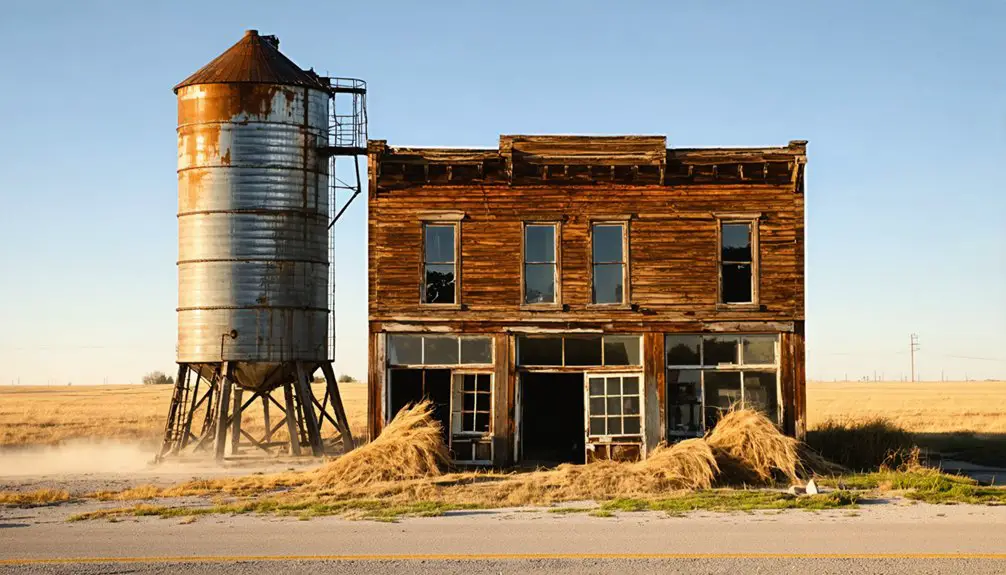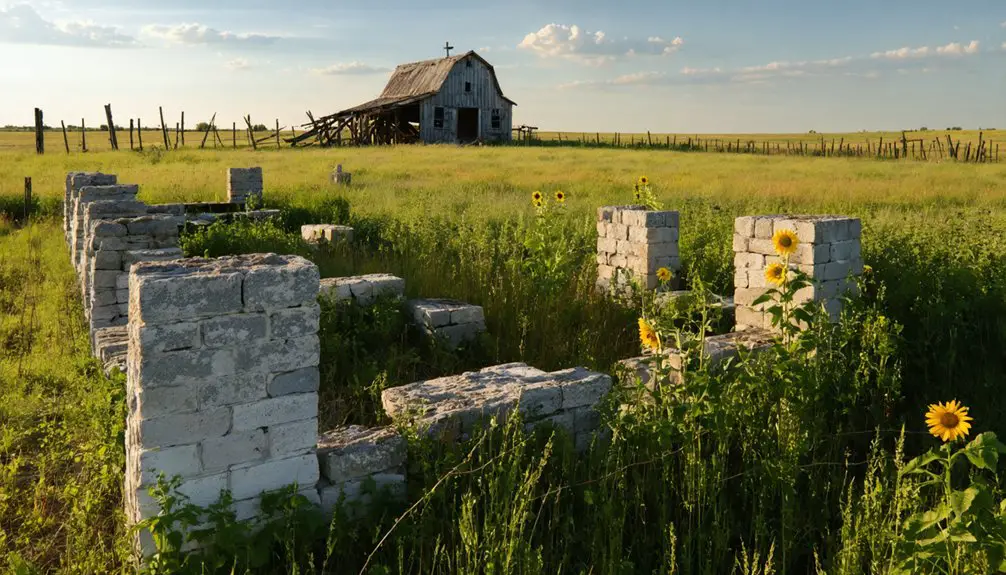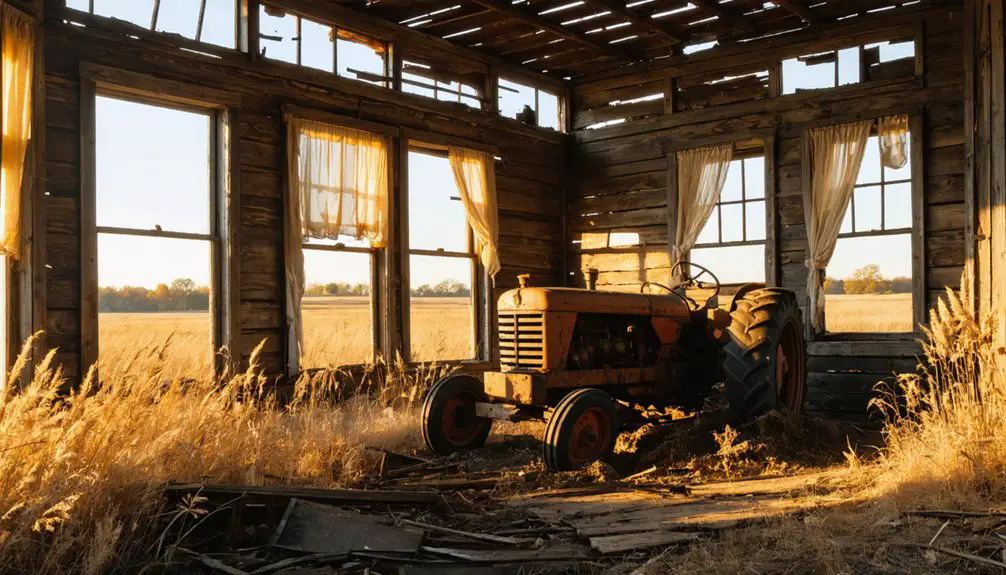You’ll find Newbury’s ghost town remnants just north of Paxico, Kansas, where ambitious settlers established it in 1870 with promises from the Santa Fe Railroad. The town boasted an eight-acre public square and attracted German Catholic immigrants who paid $1 per acre. When Santa Fe abandoned its planned route in 1886, businesses and residents fled to nearby Paxico. Today, only Sacred Heart Church and a few scattered structures reveal Newbury’s once-promising frontier dreams.
Key Takeaways
- Newbury, Kansas became a ghost town after the Santa Fe Railroad abandoned its planned route in 1886, causing businesses to relocate to Paxico.
- Founded in 1870, Newbury was established with an ambitious 640-acre layout featuring an eight-acre public square as its centerpiece.
- German Catholic settlers were the primary residents, attracted by $1-per-acre land deals from the railroad company.
- Sacred Heart Church, established in 1874, remains standing today as the main remnant of the former township.
- The town’s decline began after losing a county seat election in 1871 and accelerated when the railroad changed routes.
The Railroad’s Promise and Betrayal
When the Santa Fe Railroad initially promised to build an east-west route through Mill Creek Valley in 1870, Newbury’s founders seized the opportunity by establishing the Newbury Town Company and offering the railroad a 50% ownership stake in the town site.
You can imagine their optimism as they laid out a grand vision, including an eight-acre public square and extensive town boundaries.
Railroad negotiations intensified as German Catholic settlers moved in, purchasing land directly from the railroad. The town’s name itself honored a railroad official’s birthplace, and economic incentives seemed perfectly aligned for success.
But by 1886, everything changed. The Santa Fe Railroad abandoned its planned route, selling its right-of-way to the Chicago, Rock Island, and Pacific Railroad. This new line bypassed Newbury entirely, choosing a route 70 miles south near Paxico, which soon established its own Town Company in 1886. The Hotel Paxico was relocated from Newbury to the new town site, marking the beginning of Newbury’s decline.
From Native Lands to Frontier Settlement
Before settlers could establish Newbury, the land belonged to the Potawatomi tribe as part of their reservation.
The U.S. government’s initiatives for Native American removal in the 1830s set precedents for later displacement of tribes across the country.
The Native American heritage of the region changed dramatically in 1869 when the federal government opened the area to white settlement. The area was originally part of Richardson County before being renamed Wabaunsee County in 1859.
A seismic shift transformed indigenous lands in 1869 as federal policy cleared the way for white settlers.
You’ll find the transformation from tribal lands to frontier settlement unfolded in these key developments:
- By June 1870, only 93 Potawatomi members remained in Newbury Township.
- Early settlers, mostly Catholic Germans like Martin Muckenthaler, purchased 160 acres from the railroad.
- The Santa Fe Railroad acquired land from the government for $1 per acre to attract settlers.
- Fr. Rimmele S.J., a Jesuit advisor, influenced many German settlers’ decisions to move to the area.
Building a Dream: Town Planning and Infrastructure
As the Newbury Town Company officially chartered the settlement on April 27, 1870, they commenced an ambitious vision for their new community.
You’d have witnessed a bold town layout covering nearly 640 acres, anchored by an impressive eight-acre public square designed to be the heart of civic life.
The Atchison, Topeka and Santa Fe Railroad’s half-interest in the town company shaped every aspect of development.
You’ll find their influence reflected in everything from the town’s name – chosen after a railroad official’s birthplace – to the infrastructure investments made in anticipation of the rail line’s arrival.
Like the nearby community of Bell Plane, developers purchased the land at one dollar per acre.
A devastating blow came when Newbury lost the county seat election in 1871, triggering a mass exodus of residents.
The design centered on public spaces and promised prosperity, but when the railroad changed its route, bypassing Newbury entirely, the dream began to crumble.
Streets faded, buildings relocated, and the once-promising frontier town slipped into decline.
Sacred Heart Church: A Lasting Legacy
Sacred Heart Church has stood as Newbury’s most enduring landmark since its establishment in 1874, serving the area’s German Catholic settlers through both the town’s rise and decline.
You’ll find the church at its original location on Newbury Road, where it continues to mark the ghost town’s historic center just north of present-day Paxico. The church maintains its role as a place of worship for the local community to this day.
Even after Newbury’s economic downturn, the church remained a crucial spiritual and social anchor for the region’s Catholic community, as evidenced by its continuous baptismal records from 1890 to 1941. The church’s detailed marriage and burial records from this same period provide invaluable documentation of the area’s Catholic families.
Still Standing Strong Today
While many ghost towns fade completely into history, the enduring Sacred Heart Catholic Church stands as a tribute to Newbury’s lasting legacy.
Today, you’ll find this monument to cultural heritage and spiritual significance still serving its congregation through St. Bernard parish in Wamego.
In 1921, the church faced a devastating challenge when a bird’s nest caught fire in the belfry, threatening its survival.
Here’s what makes Sacred Heart’s continued presence remarkable:
- Founded in 1874, it’s outlived Newbury itself, adapting through major changes including the 1921 bell tower fire.
- It maintains its official presence near Paxico, preserving the area’s German Catholic roots.
- The church continues functioning as an active place of worship for local families.
- It’s one of the last physical connections to Newbury’s once-thriving community, representing both resilience and continuity.
Community Anchor Since 1870
From its establishment in 1870, Newbury emerged as a promising settlement when four Topeka businessmen formed the Newbury Town Company and secured an essential railroad partnership.
Southern German Catholics, including Martin Muckenthaler, settled the area under Fr. Rimmele’s guidance, bringing their rich cultural heritage to Kansas soil.
You’ll find the heart of their community resilience in Sacred Heart Catholic Church, built in 1884. The church stood as a beacon of faith even as Newbury’s fortunes changed when railroad routes shifted to Paxico in 1886.
While the original structure tragically burned in 1921 when a spark ignited a bird’s nest in the bell tower, the congregation’s determination never wavered.
The church’s enduring presence reflects the unwavering spirit of Newbury’s earliest settlers.
The Economic Rise and Fall

You’ll find Newbury’s economic story centered on the Santa Fe Railroad‘s initial promise, with the company holding half-ownership of the town and early settlers like Martin Muckenthaler purchasing land directly from them in 1869.
The town’s ambitious layout, including an eight-acre public square, reflected the widespread belief that the railroad would transform Mill Creek Valley into a bustling commercial hub. Today, visitors can explore the faded facades of what were once thriving businesses and storefronts.
When the railroad ultimately chose a different route, Newbury’s dreams of becoming a thriving economic center were shattered, leading to its eventual decline into a ghost town.
Railroad Dreams Derailed
Although Newbury’s founders envisioned a thriving railroad hub in 1870, their dreams would ultimately crumble due to critical route changes by major rail companies.
The town’s strategic railroad expansion plans included giving away 50% of the town site to attract rail traffic, but these efforts proved futile.
You can trace Newbury’s economic decline through these pivotal events:
- The Atchison, Topeka and Santa Fe Railroad initially promised a Mill Creek Valley route through Newbury.
- In 1886, ATSF abandoned the route and sold rights to Chicago, Rock Island, and Pacific Railroad.
- Rock Island chose to route through Paxico instead, establishing a depot on Gerhard Nuttman’s farm.
- Businesses and residents relocated to Paxico, leaving Newbury to fade into obscurity.
The town’s carefully planned eight-acre public square and elevated location couldn’t save it from the devastating impact of being bypassed by the railroad.
Business Boom Gone Bust
When Newbury first emerged in 1870, its business district showed remarkable promise, anchored by the Bolton Brothers General Store and supported by a strong agricultural market. Local business strategies centered on the anticipated Santa Fe Railroad route, which would’ve transformed the town into a bustling commercial hub.
Yet you’ll find that Newbury’s promising trajectory changed dramatically when the railroad chose an alternate route near Mill Creek. This decision sparked a mass exodus of merchants and resources to nearby Paxico.
The town’s community dynamics suffered as agricultural modernization reduced the local workforce, and younger residents sought opportunities elsewhere. Sacred Heart Church remained a social anchor, but without railroad access, Newbury’s commercial foundation crumbled.
The once-hopeful business district gradually emptied, leaving abandoned buildings as silent witnesses to broken dreams of prosperity.
Community Life in Early Newbury
As southern German Catholics arrived in Newbury around 1869, they established a close-knit community shaped by their shared faith and cultural heritage.
Religious influence guided many aspects of daily life, with Jesuit priests like Fr. Rimmele directing settlement decisions. Community gatherings centered around their Catholic faith, fostering strong social bonds among the immigrant families.
You’ll find these key aspects defined early Newbury’s social fabric:
- Families traveled together and settled in groups, strengthening their cultural connections
- Local Pottawatomie Indians provided valuable guidance on settlement locations
- Churches served as primary gathering places and community centers
- Residents supported each other through communal farming and mutual aid
The town’s social structure reflected typical German Catholic pioneer communities of the era, with clergy and immigrant leaders organizing daily life.
Modern Day Remnants and Historical Significance

Today’s remnants of Newbury offer glimpses into its ambitious railroad town origins, with the Sacred Heart Church standing as the most prominent surviving structure.
You’ll find this architectural significance visible across the prairie, though it’s now officially part of Paxico. A few residential houses and the outline of an eight-acre public square hint at the town’s grand vision.
Newbury’s cultural heritage reflects the complex story of American westward expansion. Originally part of the Potawatomi Indian Reservation, the area transformed through railroad speculation and settler colonialism.
The town’s rise and fall mirrors countless Kansas communities that bloomed with railroad promises and withered when routes changed. While commercial buildings have vanished, nearby cemeteries with German and Swedish inscriptions, including graves of Buffalo Soldiers, preserve the diverse legacy of this once-thriving community.
Frequently Asked Questions
What Was the Population of Newbury at Its Peak?
You’ll find Newbury’s exact peak population isn’t officially recorded, but town demographics suggest it likely reached between 200-500 residents in the late 1800s before declining due to railroad bypass.
Were There Any Notable Crimes or Incidents in Newbury’s History?
You won’t find any documented crime incidents in local records or legends. Despite searching through decades of historical accounts, zero notable crimes appear – suggesting this town’s story was about economic decline, not lawlessness.
What Businesses and Shops Operated in Newbury Before Its Decline?
You’d find Bolton Brothers General Store, Anderson & Co., Copp’s store, a blacksmith shop, lumber yards, Union Hall with its post office, and several saloons serving the bustling frontier community.
Did Any Famous or Historically Significant People Come From Newbury?
You won’t find nationally famous people from this town. The main historical figures were early settlers like Martin Muckenthaler and local legends like Fr. Rimmele who guided settlement efforts.
What Natural Disasters, if Any, Affected Newbury’s Development?
You’ll find flooding was the main natural disaster affecting development, with recurring flood impacts near Mill Creek. There’s no evidence of significant drought challenges or other disasters impacting the town’s trajectory.
References
- https://krex.k-state.edu/server/api/core/bitstreams/9322da4a-c65f-4aa5-8095-9cca25434b40/content
- https://wabaunseecomuseum.org/2016/10/24/paxico/
- https://www.paxicofoundation.com/TheStoryofPaxico
- https://www.mapquest.com/us/kansas/prairie-ghost-346237044
- https://www.legendsofamerica.com/gt-emergingghosttowns/
- https://legendsofkansas.com/paxico-kansas/
- https://flinthillsspecial.com/2019/08/02/depot-memories/
- https://flinthillsspecial.com/2021/10/24/minority-migration-in-wabaunsee-county-kansas-a-dark-history/
- https://legendsofkansas.com/wabaunsee-county-kansas/
- https://www.youtube.com/watch?v=OyBXD18P_j4



